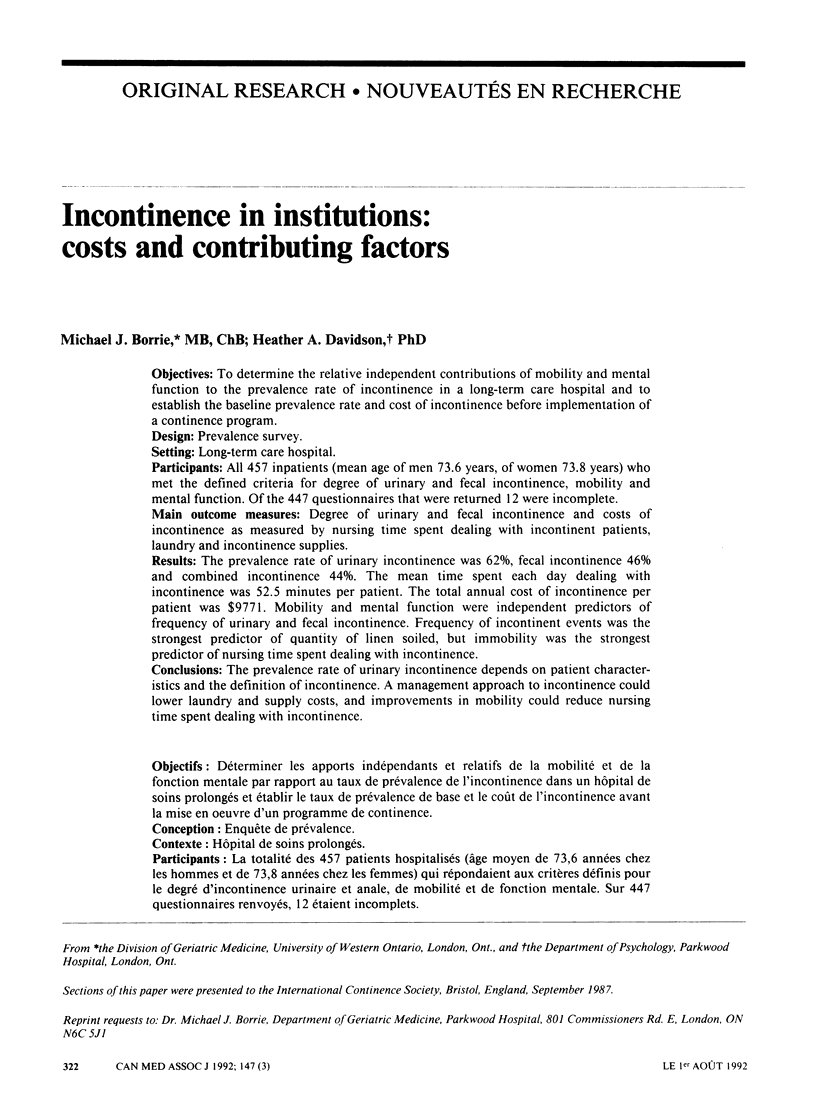Abstract
OBJECTIVES: To determine the relative independent contributions of mobility and mental function to the prevalence rate of incontinence in a long-term care hospital and to establish the baseline prevalence rate and cost of incontinence before implementation of a continence program. DESIGN: Prevalence survey. SETTING: Long-term care hospital. PARTICIPANTS: All 457 inpatients (mean age of men 73.6 years, of women 73.8 years) who met the defined criteria for degree of urinary and fecal incontinence, mobility and mental function. Of the 447 questionnaires that were returned 12 were incomplete. MAIN OUTCOME MEASURES: Degree of urinary and fecal incontinence and costs of incontinence as measured by nursing time spent dealing with incontinent patients, laundry and incontinence supplies. RESULTS: The prevalence rate of urinary incontinence was 62%, fecal incontinence 46% and combined incontinence 44%. The mean time spent each day dealing with incontinence was 52.5 minutes per patient. The total annual cost of incontinence per patient was $9771. Mobility and mental function were independent predictors of frequency of urinary and fecal incontinence. Frequency of incontinent events was the strongest predictor of quantity of linen soiled, but immobility was the strongest predictor of nursing time spent dealing with incontinence. CONCLUSIONS: The prevalence rate of urinary incontinence depends on patient characteristics and the definition of incontinence. A management approach to incontinence could lower laundry and supply costs, and improvements in mobility could reduce nursing time spent dealing with incontinence.
Full text
PDF






Selected References
These references are in PubMed. This may not be the complete list of references from this article.
- Bates P., Bradley W. E., Glen E., Griffiths D., Melchior H., Rowan D., Sterling A., Zinner N., Hald T. The standardization of terminology of lower urinary tract function. J Urol. 1979 May;121(5):551–554. doi: 10.1016/s0022-5347(17)56874-3. [DOI] [PubMed] [Google Scholar]
- Cella M. The nursing costs of urinary incontinence in a nursing home population. Nurs Clin North Am. 1988 Mar;23(1):159–168. [PubMed] [Google Scholar]
- Fernie G. R., Jewett M. A., Autry D., Holliday P. J., Zorzitto M. L. Prevalence of geriatric urinary dysfunction in a chronic care hospital. Can Med Assoc J. 1983 May 1;128(9):1085–1086. [PMC free article] [PubMed] [Google Scholar]
- Hu T. W. The economic impact of urinary incontinence. Clin Geriatr Med. 1986 Nov;2(4):673–687. [PubMed] [Google Scholar]
- Jewett M. A., Fernie G. R., Holliday P. J., Pim M. E. Urinary dysfunction in a geriatric long-term care population: prevalence and patterns. J Am Geriatr Soc. 1981 May;29(5):211–214. doi: 10.1111/j.1532-5415.1981.tb01768.x. [DOI] [PubMed] [Google Scholar]
- Mohide E. A. The prevalence and scope of urinary incontinence. Clin Geriatr Med. 1986 Nov;2(4):639–655. [PubMed] [Google Scholar]
- Ouslander J. G., Kane R. L., Abrass I. B. Urinary incontinence in elderly nursing home patients. JAMA. 1982 Sep 10;248(10):1194–1198. [PubMed] [Google Scholar]
- Williams M. E., Pannill F. C., 3rd Urinary incontinence in the elderly: physiology, pathophysiology, diagnosis, and treatment. Ann Intern Med. 1982 Dec;97(6):895–907. doi: 10.7326/0003-4819-97-6-895. [DOI] [PubMed] [Google Scholar]
- Yu L. C., Kaltreider D. L. Stressed nurses dealing with incontinent patients. J Gerontol Nurs. 1987 Jan;13(1):27–30. doi: 10.3928/0098-9134-19870101-08. [DOI] [PubMed] [Google Scholar]


